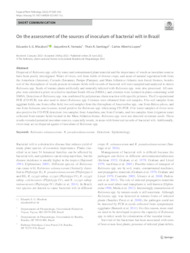On the assessment of the sources of inoculum of bacterial wilt in Brazil.
On the assessment of the sources of inoculum of bacterial wilt in Brazil.
Author(s): MIZUBUTI, E. S. G.; YAMADA, J. K.; SANTIAGO, T. R.; LOPES, C. A.
Summary: Dispersal of Ralstonia spp. cells by water and contaminated plant material and the importance of weeds as inoculum sources have been poorly investigated. Water of rivers, soil from fields of diverse crops and areas of natural vegetation both from the Amazônia, Cerrado and Mata Atlântica biomes, besides soil of the rhizosphere of weeds present in tomato fields with records of bacterial wilt were sampled and analyzed to detect Ralstonia spp. Seeds of tomato plants artificially and naturally infected with Ralstonia spp. were also processed. All samples were enriched a priori in selective medium South Africa (SMSA) and colonies were isolated in plates containing solid SMSA. Detection of Ralstonia spp. was confirmed by polymerase chain reaction with specific primers. The Co ? operational PCR (CO-PCR) was also used to detect Ralstonia spp. Colonies were obtained from soil samples and from a commercial substrate sample. Five soil samples from eggplant fields, one from coffee field, one substrate from potato seed tuber production, two soil samples from the rhizosphere of Amaranthus spp., one from Bidens pilosa and one from Solanum americanum tested positive for Ralstonia spp. Besides these soil samples, five water samples of rivers were positive for CO-PCR detection: two samples from Amazônia, one from Cerrado and two samples from irrigation water collected from tomato fields located in the Mata Atlântica biome. Ralstonia spp. were not detected in tomato seeds. These results revealed potential inoculum sources, especially weeds, in areas with historical records of bacterial wilt. Additionally, rivers may act as dispersal agents of inoculum of Ralstonia spp.
Publication year: 2022
Types of publication: Journal article
Unit: Embrapa Vegetables
Keywords: Bacterial wilt, Batata, Berinjela, Café, Murcha Bacteriana, Ralstonia Solanacearum, Solo, Tomate
Observation
Some of Embrapa's publications are published as ePub files. To read them, use or download one of the following free software options to your computer or mobile device. Android: Google Play Books; IOS: iBooks; Windows and Linux: Calibre.
Access other publications
Access the Agricultural Research Database (BDPA) to consult Embrapa's full library collection and records.
Visit Embrapa Bookstore to purchase books and other publications sold by Embrapa.

